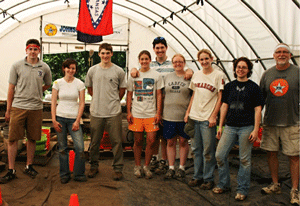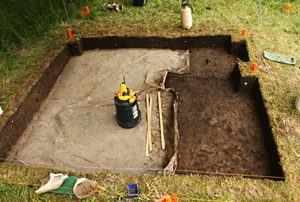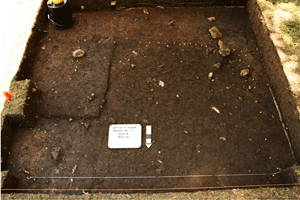 We began last week working in Block 6, the prison hospital. Our work was centered in 2 by 2 m units in the middle of the hospital. The hospital had wooden plank floors, so we expected to find only objects that would have fallen through. During excavation and screening, we discovered both historic artifacts–such as nails, glass, bone, and brick–as well prehistoric ones from earlier Native American occupations. This mix of artifacts in the top layer of soil is because the area was plowed in the past by farmers. Every artifact discovered was kept and those that were especially interesting were designated as field specimens (FS) and were recorded separately.
We began last week working in Block 6, the prison hospital. Our work was centered in 2 by 2 m units in the middle of the hospital. The hospital had wooden plank floors, so we expected to find only objects that would have fallen through. During excavation and screening, we discovered both historic artifacts–such as nails, glass, bone, and brick–as well prehistoric ones from earlier Native American occupations. This mix of artifacts in the top layer of soil is because the area was plowed in the past by farmers. Every artifact discovered was kept and those that were especially interesting were designated as field specimens (FS) and were recorded separately.

The new section reaches the level excavated in 1996.
We also began preparing for the new area we were going to open, the second of three latrines used behind Block 6 between 1862 and 1864. This involved using a surveyoris transit (a total station) to map out the location of the latrine from previous survey and historical documents. For many of us this was our first experience using a transit. Most of the topsoil above the latrine had already been excavated to subsoil in 1996, except for a small 2 x 1 m section.
By the end of the week we had gained more excavation experience and we shifted our focus to two areas of the latrine, with half of our team shoveling out the section that had already been excavated in 1996 and the rest carefully excavating the 2 x 1 m section. Once we had shoveled the soil down, we carefully excavated the rest of the soil out to expose plastic that had been laid down over the previous excavation. The group working on the 2 x 1 m section concentrated on excavating their section down to the level of the plowzone-subsoil interface. A wall had been left up between the originally excavated section and the unexcavated 2 x 1 m section to keep them separate, as the soil from the 2 x 1 m section was screened for artifacts while the rest of the soil was backfill from a previous excavation and did not need to be screened.
![[image]](https://interactive.archaeology.org/johnsons/fieldreports/images_fieldreports/picture2.gif)
We were also introduced to the world experienced by those at the prison through transcribed letters from prisoners and union soldiers, as well as published diaries from both Johnsonis Island and Andersonville. At lunch we read from published diaries, unpublished letters, and also the letters we have been transcribing.
This week things were busier. On Monday, we spent the day leveling out the latrine excavation by exposing the edges of the tarp marking the previous excavation and straightening the walls. We were joined by a CRM (cultural resource management) group learning how to conduct Phase I survey. They were tasked with locating a well thought to be inside the prison yard between Block 5 and Block 6.
Tuesday was even busier, with both the CRM group and a group of middle-school teachers visiting the site. We continued to even out the soil surface in preparation for the removal of the tarp and ensuring that the 2 x 1 m section was level with the previous excavation. We also spent part of the afternoon assisting the teachers in screening and excavating at the site.

The 1996 tarp is removed and the latrine revealed!
On Wednesday we finished making the 2 x 1 m section level with the tarp and removed the wall separating the two sections of the latrine. We watered down the area to make changes in soil color clearly visible so that we could see where the actual latrine began. Subsoil appeared as orange-yellow, while the latrine itself was much darker. The feature was clearly visible on the previous excavation, as it has been preserved by the tarp. Part of the team concentrated on scraping the loose dirt off the 2 x 1 m section so that we could find the latrine line where it crossed into the section. This was accomplished in the last few minutes of the day! The rest of the team resumed excavation within Block 6, but concentrated on three new units near the back. We finished the exposure of the latrine by Friday, got it mapped and will be ready to begin its excavation next week. More reports next week!

